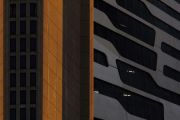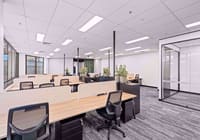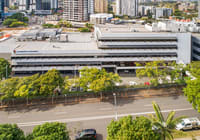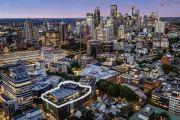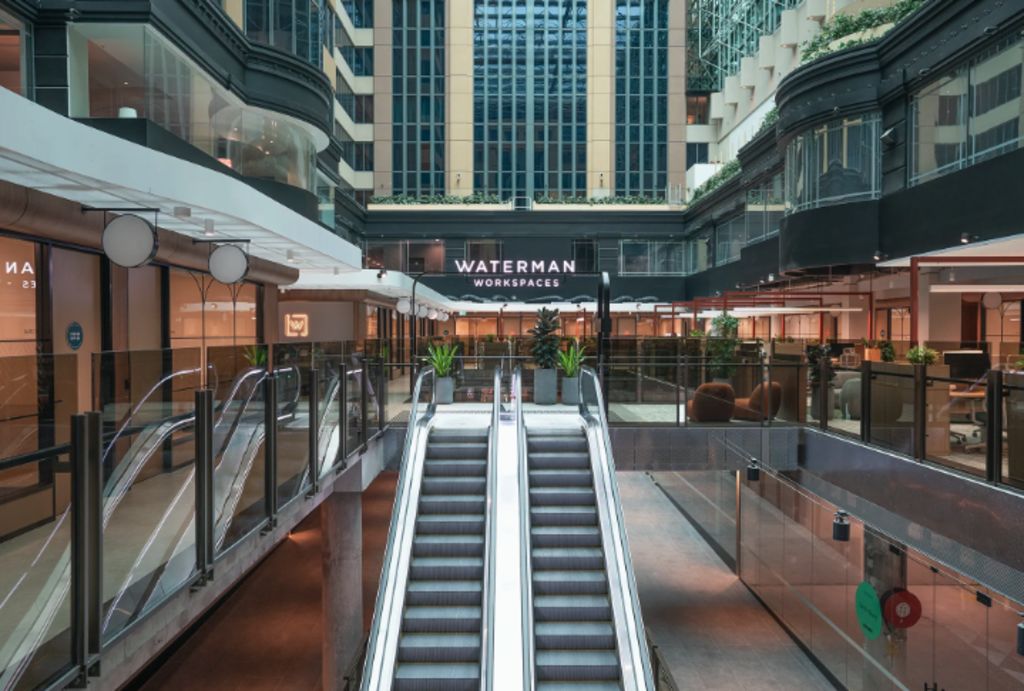
Collins Arcade reopens with a gritty new Melbourne feel and a co-working hub
Melbourne’s newest shopping, working and lifestyle precinct has officially opened, with the long-anticipated relaunch of 260 Collins Street as Collins Arcade – a “grittier”, more grounded and deliberately Melbourne-centric reinterpretation of the former “ostentatious” St Collins Lane.
The $50 million, year-long repositioning by Kaipara Property Group and UBS Asset Management involved a significant reconfiguration of the four-level centre, which was also previously known as Australia on Collins.
The revamp included the “challenging” removal of four escalators while Novotel Melbourne on Collins continued trading above, in the block between Swanston and Elizabeth streets.
“There were far too many escalators in what was a relatively tight centre,” says Kaipara co-founder Toby Daniel. “It helps the sidelines, it helps natural light, and just opens the thing up much more.”
Escalators remain between every floor to retain efficient pedestrian flow through the 11,500-square-metre centre, which now combines entertainment on lower ground, retail at street level, wellness on level one, and office and fitness tenants on level two.
Daniel says the intent was clear: “To make it more everyday accessible. Previously, it was quite high-end and luxury and a little bit ostentatious, not necessarily Melbourne.”
A CBD co-working debut for Waterman Workspaces
The most significant shift in the building’s new identity is the arrival of Waterman Workspaces, which has launched its first CBD location after years of operating solely in Melbourne’s suburbs, closer to where workers reside.
“It was never our intention to have a CBD workspace,” says Waterman head of property Peter Tainsh. Members pushed for expansion, he explains, often saying: “Listen, I’ve got somebody flying in from Tokyo … they’re not going to come away to Chadstone or Eastland. Can you get a workspace in the CBD?”
The 24/7 facility is already attracting professional services firms and established businesses. Tainsh says Waterman’s model emphasises community, business growth and the kind of networking that suburban members can now extend into the city.
“There are all sorts of things happening to try and get the community connected with each other,” he says. “It can be quite lonely for a lot of businesses … it becomes like this little incubator.”
The 2000-square-metre space is Waterman’s seventh opening this year, part of a broader rollout across its 16 Melbourne locations.
‘If you’re on Collins Street, you matter’: Why tenants are circling
One of Waterman’s key foundation tenants is the global engineering firm Azzo, which chose Collins Arcade for strategic industry proximity rather than convenience.
“If you’re on Collins Street, you matter,” says chief executive James DiLiberto, noting the firm’s major energy-sector clients – AGL, Shell, AEMO and Pacific Blue – are all nearby. “This was all about Collins Street, as part of Melbourne, and it’s the energy row.”
DiLiberto says the presence instantly elevated their profile. “All the major energy companies are here … all of our customers are here. So this grip, and being right in the middle, right next to Flinders, it’s incredible.”
The location also supports staff flexibility, with DiLiberto saying: “We just wanted something in the city that could draw from all around Melbourne suburbs, and be a place where everybody can come in as a hub.”
Azzo, with 25 Melbourne staff and 85 globally, operates largely through hot-desking and views co-working environments as a way to foster connection. “We went, ‘why don’t we put the teams into these co-working environments where they can kind of rub shoulders and cross paths with other like minded businesses?’” DiLiberto says.
A laneway-driven design for an authentically Melbourne feel
The new Collins Arcade – designed by global architecture practice Buchan, which is also masterminding the Jam Factory redevelopment – reopens a key pedestrian link between Flinders Street Station and Bourke Street Mall, following its temporary closure last September.
The new design strips back that formality, enabling the building to express its environment more naturally, with different feels on each level.
Bluestone throughout the ground floor ties into the footpaths out the front with “lots of exposed concrete and surfaces”, adding to the textured feel, Daniel says. “Gritty … but not too gritty … the bluestone is pretty dark,” Daniel adds, referring to Melbourne’s reputation for black clothing.
On level two, Tainsh describes the Waterman’s space as more refined than the raw, laneway feel on retail-heavy ground floor, while remaining consistent with Melbourne’s architecture. Inside, their design incorporates elements from the Block Arcade, such as arch-shaped office windows.
A balanced tenant ecosystem driving traffic
Daniel says the precinct was curated as an ecosystem in which each level activates the others. Waterman brings office workers through the centre daily, while Kingpin – an entertainment anchor on lower ground – will deliver heavy foot traffic from the opposite end of the experience spectrum.
“Lots of sports simulation with batting cages … lawn bowls and 10-pin bowling,” Daniel says of Kingpin 2.0. “We expect between those two to drive a lot of traffic and be really, really great fun offers for customers.”
Level one focuses on wellness, with Priceline anchoring the floor alongside operators such as Yuki House and Xtra Clubs.
The centre reached more than 90 per cent lease commitment before its official launch last week, with tenants including Birkenstock, TAG Heuer, Swatch, Kathmandu, Tommy Hilfiger, Politix, SABA and 2XU.
A landmark site revived after decades of reinvention
The building’s history stretches back to the 1930s Hotel Australia, which was replaced in 1992 by Australia on Collins. St Collins Lane arrived in 2016 but struggled with vacancies before the pandemic accelerated its decline.
Daniel says Collins Arcade now reflects what the city needs: a right-sized, accessible retail and workplace hub in a prime CBD location. The reopening of the internal Collins to Little Collins link has restored a classic shortcut between Flinders Street Station, Degraves Street and Bourke Street Mall – one shoppers and commuters have used “for a long, long time”.
“We were very confident about this particular property because of its location – its address is a major strength of the building,” Daniel says. “Collins Street is one of the best addresses in the world.”
With Town Hall Station set to open 70 metres away, multiple new hotels nearby and foot traffic returning to pre-pandemic levels, Collins Arcade is one to watch.


